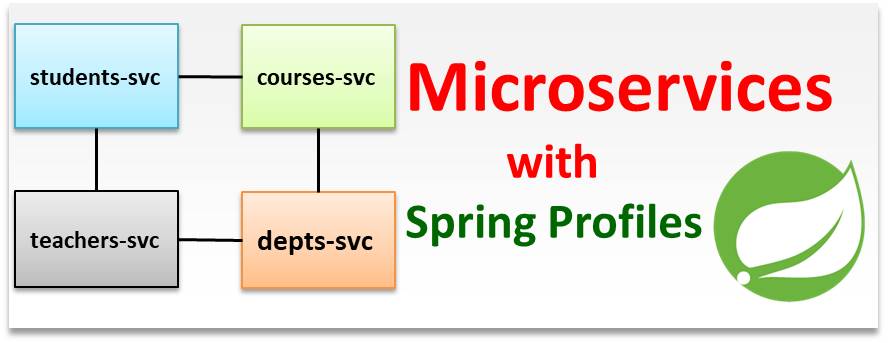Previously in this Tutorial, we learnt how to split a single structured monolith into microservices. We did this using Spring Profiles.
In this lesson, we would learn how to configure multiple databases for a structured monolithic application. This is very important if you are testing the performance of different database scenarios for database per service (DBPS) microservice architecture.
1. Prerequisites
- MySQL Database
- PostgreSQL (Optional)
- MS SQL Database (Optional)
In this demo, we would only use two datasources: MySQL and PostgreSQL. We do this for simplicity and clarity.
You can also use two MySQL databases just to follow this demo.
Before you start: Create a database in MySQL called admissionsdb and another database in PostgreSQL call appointmentsdb.
2. How It Works
It would be similar to your normal application but with a few changes
- The application.properties file would now contain multiple setting each for a different datasource
- You need configuration classes, one for each of the datasources. One of the configuration classed must be set as Primary using the @Primary annotation.
- The configuration classes would contain mandatory methods:
- DataSource method
- LocalContainerEntityManagerFactoryBean method
- PlatformTransactionManager method
- Of course, you need a model class and a repository interface.
So, let’s give it a shot!
We would be using IntelliJ in this demo. However, the complete project can be found here in my GitHub repository. Feel free to clone or download it
Step 1: Create a spring application and create two packages admissions and appointments
Step 2: Create a the Appointment class in the appointment package. The Appointment Class is shown below:
@Entity @Data @AllArgsConstructor @NoArgsConstructor @Table(name="appointment") public class Appointment { @Id private int id; private String status; }
Step 3: Create the Admission Class in the admission package. The admissions class is shown below:
@Entity @Data @AllArgsConstructor @NoArgsConstructor @Table(name="admission") public class Admission { @Id private int id; private String description; }
Step 4: Create the AppointmentRepository interface in the appointments package
Step 5: Create the AdmissionRepository interface in the admissions package
Step 6: Open the application.properties file and add the following settings for MySQL and PostgreSQL
#Appointments Datasource spring.appointments.datasource.jdbcUrl=jdbc:postgresql://localhost:5432/appointmentsdb spring.appointments.datasource.username=postgres spring.appointments.datasource.password=root #Admissions Datasource spring.admissions.datasource.jdbcUrl=jdbc:mysql://localhost:3301/admissionsdb?serverTimezone=UTC spring.admissions.datasource.username=root spring.admissions.datasource.password=root spring.admissions.datasource.driver-class-name=com.mysql.cj.jdbc.Driver spring.jpa.generate-ddl=true spring.jpa.show-sql=true
You can see the setting for the two datasources. Take note that the datasources are differentiated based on the prefixes: spring.admissions and spring.appointments. Now, if you want to add more data sources, do feel free.
The last two statements applies to both datasources.
Step 7: Now create the AdmissionsDBConfig class inside the admissions package. Annotate this class with annotations as shown below:
@Configuration @EnableTransactionManagement @EnableJpaRepositories( entityManagerFactoryRef = "entityManagerFactory" ) public class AdmissionsDBConfig { // Datasource method goes here // LocalContainerEntityManagerFactoryBean goes here // PlatformTransactionManager goes here }
Step 8: Write the function that returns the admissions datasource. This is shown below:
@Primary @Bean(name="datasource") @ConfigurationProperties(prefix = "spring.admissions.datasource") public DataSource dataSource(){ return DataSourceBuilder.create().build(); }
Take note that in this listing the function is annotated with the @Primary annotation
Step 9: Write the function that returns a LocalContainerEntityManagerFactory. Also annotated with @Primary annotation as shown below
@Primary @Bean(name="entityManagerFactory") public LocalContainerEntityManagerFactoryBean entityManagerFactoryBean( EntityManagerFactoryBuilder builder, @Qualifier("datasource") DataSource dataSource ) { Map<String, Object> properties = new HashMap<>(); properties.put("hibernate.hbm2ddl.auto", "update"); properties.put("hibernate.dialect", "org.hibernate.dialect.MySQL5Dialect"); return builder .dataSource(dataSource) .properties(properties) .packages("com.kindsonthegenius.multipledb.admissions") .persistenceUnit("Admission") .build(); }
Step 10: Write the function that returns the transactionManager object
@Primary @Bean(name="transactionManager") public PlatformTransactionManager transactionManager( @Qualifier("entityManagerFactory") EntityManagerFactory entityManagerFactory ) { return new JpaTransactionManager(entityManagerFactory); }
Step 11: Repeat steps 7 to 10 but this time for the appointment package.
Also remember: Remove the @Primary annotation for the methods in the AppointmentsDBConfig.
The complete content of the AppointmentsDBConfig is given below:
@Configuration @EnableTransactionManagement @EnableJpaRepositories( entityManagerFactoryRef = "appointmentsEntityManagerFactory", transactionManagerRef = "appointmentsTransactionManager" ) public class AppointmentsDBConfig { @Bean(name="appointmentsDatasource") @ConfigurationProperties(prefix = "spring.appointments.datasource") public DataSource dataSource(){ return DataSourceBuilder.create().build(); } @Bean(name="appointmentsEntityManagerFactory") public LocalContainerEntityManagerFactoryBean entityManagerFactoryBean( EntityManagerFactoryBuilder builder, @Qualifier("appointmentsDatasource") DataSource dataSource ) { return builder .dataSource(dataSource) .packages("com.kindsonthegenius.multipledb.appointments") .persistenceUnit("Appointments") .build(); } @Bean(name="appointmentsTransactionManager") public PlatformTransactionManager transactionManager( @Qualifier("appointmentsEntityManagerFactory") EntityManagerFactory entityManagerFactory ) { return new JpaTransactionManager(entityManagerFactory); } }
3. Insert and Query Some Test Data
Follow the steps below.
Step 1: Open the main application class. Annotate this class with the @RestController annotation (we are going to add REST endpoints here) . This is done for simplicity as you could also have create separate controller classes.
Step 2: Autowire both the AppointmentRepository and the AdmissionRepository into this class. The code is shown below:
@Autowired private AdmissionRepository admissionRepository; @Autowired private AppointmentRepository appointmentRepository;
Step 3: Add a method annotated with @PostConstruct to add some appointments data into the appointments database
Step 4: Add a method annotated with @GetMapping(“/getAppointments”) to retrieve list of appointments. Both methods are shown below:
/****************************************************************************** * ENDPOINTS FOR APPOINTMENTS SERVICE ******************************************************************************/ @PostConstruct public void addAppointmentsData() { appointmentRepository.saveAll(Stream.of( new Appointment(101, "Teh first appointment ever"), new Appointment(102, "Appointment with a Dentist")) .collect(Collectors.toList())); } @GetMapping("/getAppointments") public List<Appointment> getAppointmens(){ return appointmentRepository.findAll(); }
Note: You could also write a simpler code by creating and inserting appointments one by one. You could also use a data.sql file placed inside src/main/resources folder.
Step 5: Repeat step 3 and step 4 for the admissions database.
At this point, we are good to go!
Step 7: Run the application and visit http://localhost:8080/getAdmissions and do same for Appointment.
If everything went successfully, then thumbs up to you! Else, clone the repository and check where you got it wrong.

